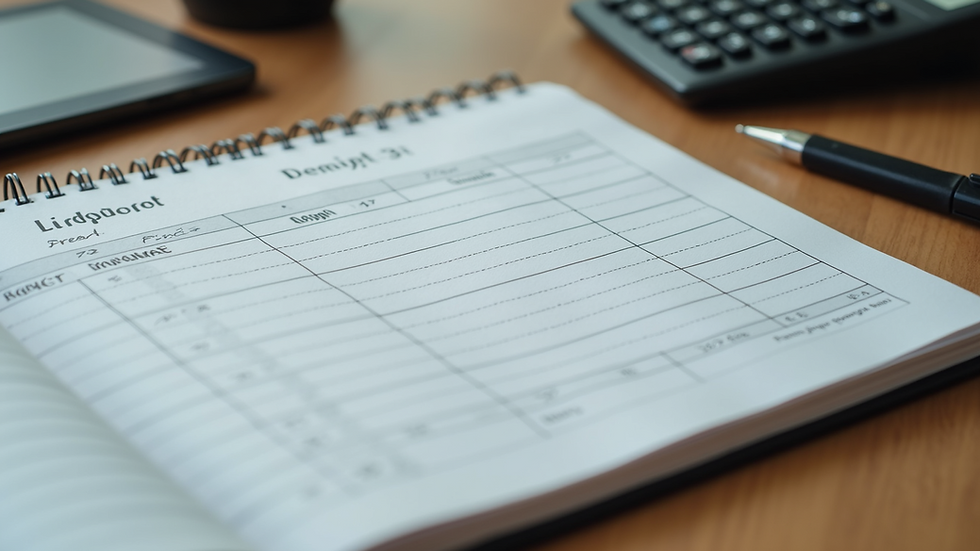Steps to Effective Financial Planning
- Bryan Knutson

- Oct 15
- 4 min read
When I first started thinking about managing money, it felt overwhelming. There were so many things to consider - saving, spending, investing, and planning for the future. But breaking it down into clear steps made it easier. Effective financial planning is not just for adults with big incomes. It’s something anyone can learn, especially teens and their parents who want to build a strong foundation for the future. Let's go through some essential steps to get started with finance planning basics.
Understanding Finance Planning Basics
Finance planning basics are about setting goals and making a plan to reach them. It’s like creating a roadmap for your money. You decide where you want to go financially and figure out the best way to get there. This includes budgeting, saving, managing debt, and investing wisely.
Here’s a simple way to think about it:
Set clear goals: What do you want to achieve? Maybe it’s saving for college, buying a car, or building an emergency fund.
Know your income and expenses: Track how much money you get and where it goes.
Create a budget: Plan how to spend and save your money each month.
Save regularly: Even small amounts add up over time.
Avoid unnecessary debt: Use credit wisely and pay off what you owe on time.
By mastering these basics, you can avoid common money mistakes and feel more confident about your financial future.

Setting Realistic Financial Goals
One of the first steps in effective financial planning is setting realistic goals. Goals give you direction and motivation. Without them, it’s easy to spend money without thinking about the future.
Start by asking yourself:
What do I want to achieve in the next year? (Short-term goals)
What about in the next 5 years? (Medium-term goals)
What are my long-term dreams? (Long-term goals)
For example, a short-term goal might be saving $500 for a new laptop. A medium-term goal could be saving for a car or college tuition. Long-term goals might include buying a house or planning for retirement.
Make your goals specific, measurable, achievable, relevant, and time-bound (SMART). Instead of saying “I want to save money,” say “I want to save $100 each month for the next 6 months.”
Writing down your goals and reviewing them regularly helps keep you on track.

What kind of education does a financial planner need?
If you’re thinking about becoming a financial planner or just want to understand how they help, it’s good to know what kind of education they need. Financial planners usually study subjects like finance, economics, accounting, or business. Earning a certification such as Certified Financial Planner (CFP)- which I received in 2008- can show they have the skills and knowledge to guide others.
For those interested in learning more about managing money themselves, seeking out quality financial planning education is a great step. This kind of education teaches you the basics of budgeting, saving, investing, and avoiding debt. It’s designed to help you make smart money decisions and build confidence.
Whether you want to become a professional or just improve your own skills, understanding the education behind financial planning can be very helpful.

Creating a Budget That Works for You
Budgeting is the heart of financial planning. It’s how you control your money instead of letting money control you. A budget helps you see where your money goes and find ways to save.
Here’s how to create a budget that works:
List your income: Include all sources like allowance, part-time jobs, or gifts.
Track your expenses: Write down everything you spend money on for a month.
Categorize expenses: Group them into needs (food, transportation) and wants (entertainment, eating out)- plus aspirational targets to be called wishes.
Set spending limits: Decide how much you want to spend in each category.
Plan to save: Treat saving like a regular expense. Aim to save at least 10% of your income.
Review and adjust: Check your budget monthly and make changes if needed.
Using apps or simple spreadsheets can make budgeting easier. The key is to be honest and consistent.
Building Good Money Habits Early
The habits you build now will shape your financial future. Good money habits help you avoid debt, save for important things, and feel secure.
Some habits to start today:
Save first, spend later: Put money into savings as soon as you get it.
Avoid impulse buying: Wait 24 hours before making some larger purchases.
Use cash or debit cards: This helps you spend only what you have.
Keep track of your spending: Know where your money goes.
Set financial goals: Keep your eyes on what you want to achieve.
These habits might seem small, but over time they add up to big results.

Taking Control of Your Financial Future
Financial planning is a journey, not a one-time task. The more you learn and practice, the better you get at managing your money. Remember, it’s okay to make mistakes as long as you learn from them.
If you want to dive deeper, check out resources that offer financial planning education. They can provide tools, tips, and support to help you succeed.
By following these steps and staying committed, you’ll build confidence and avoid common money mistakes. You’ll be ready to navigate your financial future with ease and peace of mind.
Start today, and watch how your financial life improves step by step!




Comments